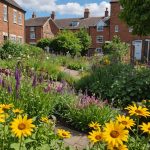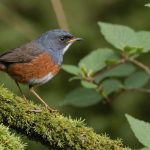Revitalizing UK Urban Gardens: Innovative Strategies to Boost Declining Pollinator Populations
The Importance of Pollinators in Urban Gardens
Pollinators, including bees, butterflies, and other insects, are the unsung heroes of our ecosystem. Without them, many of the plants we rely on for food and beauty would not be able to reproduce. However, pollinator populations, particularly bees, are facing significant declines due to various factors such as habitat loss, pesticide use, and climate change.
In the UK, urban gardens play a crucial role in supporting these vital insects. Here’s why:
A lire en complément : Empowering UK Landowners: A Guide to Reviving Natural Habitats for Endangered Species
- Bee Populations: Bees, including honey bees (Apis mellifera), bumble bees, and solitary bees, are among the most important pollinators. Urban gardens can provide the necessary habitats and food sources for these bees, helping to maintain their populations.
- Plant Diversity: Urban gardens can host a wide variety of plants, including native and non-native species. Native plants, in particular, are more likely to attract native pollinators, as they have co-evolved together.
- Community Engagement: Urban gardens often involve community efforts, which can foster a sense of ownership and responsibility towards pollinator conservation.
Designing Pollinator-Friendly Gardens
Creating a pollinator-friendly garden is not just about planting a few flowers; it requires a thoughtful and holistic approach.
Choosing the Right Plants
When selecting plants for your garden, it’s essential to choose those that are pollinator-friendly. Here are some tips:
Dans le meme genre : Empowering UK Farmers: Sustainable Agricultural Practices to Protect Barn Owl Populations
- Native Plants: Incorporate native plants that are specific to your region. These plants are more likely to attract local pollinators.
- Examples include lavender, coneflower, and black-eyed Susan.
- Bee-Friendly Flowers: Opt for flowers that are rich in nectar and pollen, such as sunflowers, zinnias, and cosmos.
- Seasonal Variety: Ensure there is a variety of plants that bloom at different times of the year to provide a constant source of food for pollinators.
### Examples of Pollinator-Friendly Plants
- **Spring Blooms**
- Crocus
- Daffodil
- Apple blossoms
- **Summer Blooms**
- Lavender
- Sunflowers
- Zinnias
- **Autumn Blooms**
- Asters
- Chrysanthemums
- Sedum
- **Winter Blooms**
- Winter heather
- Snowdrops
- Hellebores
Garden Design Considerations
The design of your garden can significantly impact its attractiveness to pollinators.
- Diverse Habitats: Create diverse habitats by including a mix of flowers, shrubs, and trees. This diversity will attract a wider range of pollinators.
- Ground Nesting Sites: Many solitary bees are ground-nesting, so leaving some areas of the garden unmanicured and undisturbed can provide them with nesting sites.
- Water Sources: Provide shallow water sources, like birdbaths or shallow dishes, with rocks or twigs for pollinators to land on while drinking.
Community-Led Initiatives and Urban Planning
Community involvement and urban planning strategies are crucial for large-scale pollinator conservation.
Edgware Road Placemaking Strategy
A recent example of community-led urban planning is the Edgware Road placemaking strategy in London. This initiative, developed by Marble Arch London BID, The Portman Estate, and The Church Commissioners, includes public realm improvements that focus on enhancing green spaces and public art. Such projects can significantly benefit pollinators by:
- Green Infrastructure: Incorporating more green spaces, like the Marylebone Flyover Rain Gardens, which include trees, shrubs, and bulbs, can provide habitats and food sources for pollinators.
- Community Engagement: Engaging local residents, businesses, and community groups in the planning process ensures that the needs of both the community and pollinators are met.
Urban Green Spaces Case Studies
Other UK cities have also seen the benefits of integrating green spaces into urban planning:
- Manchester’s Green Streets: This programme converted underutilised areas into vibrant parks and gardens, significantly improving public health and increasing physical activity levels among residents. Such green spaces also support pollinator populations by providing habitats and food sources.
- Bristol’s Urban Green Spaces: Bristol’s commitment to expanding its urban green spaces has improved air quality and increased community engagement. These green spaces are essential for maintaining biodiversity and supporting pollinators.
Adaptive Reuse and Urban Renewal
Adaptive reuse and urban renewal projects can also play a role in revitalizing urban gardens and supporting pollinators.
Revitalizing Existing Structures
Projects like the Battersea Power Station redevelopment in London demonstrate how historic structures can be repurposed to include green spaces and public areas that benefit pollinators.
- Battersea Power Station: The redevelopment retained much of the original structure and incorporated roof gardens and green spaces, providing habitats for pollinators while also serving as a social destination.
Urban Renewal and Conservation
Urban renewal efforts should prioritize conservation and the integration of green spaces to support pollinators.
- Richmount Gardens: While the redevelopment of Richmount Gardens in Blackheath highlights the challenges of balancing housing needs with green space preservation, it also underscores the importance of maintaining community-focused green spaces. These spaces are crucial for both community well-being and pollinator conservation.
Practical Advice for Gardeners
Here are some practical tips for gardeners looking to support pollinators:
Avoid Pesticides
Pesticides can be harmful to pollinators, so it’s best to avoid using them in your garden.
- Natural Pest Control: Instead, use natural pest control methods such as introducing beneficial insects or using physical barriers.
- Organic Gardening: Adopt organic gardening practices to maintain a healthy and balanced ecosystem.
Provide Nesting Sites
Many pollinators, especially solitary bees, need specific nesting sites.
- Bee Hotels: Create or purchase bee hotels to provide nesting sites for solitary bees.
- Ground Nesting Areas: Leave some areas of your garden undisturbed to allow ground-nesting bees to create their nests.
Educate and Engage
Education and community engagement are key to widespread pollinator conservation.
- Workshops and Events: Organize workshops or events to educate your community about the importance of pollinators and how to support them.
- Community Gardens: Participate in or start a community garden where members can work together to create pollinator-friendly habitats.
### Tips for Creating a Pollinator-Friendly Garden
- **Plant a variety of flowers** that bloom at different times of the year.
- **Avoid using pesticides** and opt for natural pest control methods.
- **Provide nesting sites** such as bee hotels or undisturbed ground areas.
- **Include a source of water** with rocks or twigs for pollinators to land on.
- **Engage your community** through workshops and community garden projects.
Revitalizing UK urban gardens to support declining pollinator populations is a multifaceted effort that requires innovative strategies, community engagement, and thoughtful urban planning. By choosing the right plants, designing gardens with pollinators in mind, and engaging in community-led initiatives, we can create vibrant, pollinator-friendly urban spaces.
As Kay Buxton, Chief Executive of Marble Arch London BID, noted, “This placemaking strategy, driven by the insights of local people, will help guide investment and ensure Edgware Road remains an active, inclusive, safe and resilient neighbourhood that celebrates and enhances the area’s sociable and multicultural character”.
By working together, we can ensure that our urban gardens not only beautify our cities but also provide essential habitats for the pollinators that are so crucial to our environment and our world. As the world grapples with climate change and biodiversity loss, every garden, no matter how small, can make a significant difference in supporting these vital insects.











